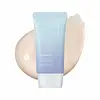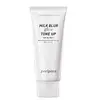What's inside
What's inside
 Key Ingredients
Key Ingredients

 Benefits
Benefits

 Concerns
Concerns

 Ingredients Side-by-side
Ingredients Side-by-side

Water
Skin ConditioningDibutyl Adipate
EmollientTitanium Dioxide
Cosmetic ColorantDiethylamino Hydroxybenzoyl Hexyl Benzoate
UV FilterPhenyl Trimethicone
Skin ConditioningOctyldodecanol
EmollientHydrogenated Polyisobutene
EmollientButylene Glycol
HumectantPropanediol
SolventGlycerin
HumectantLauryl PEG-10 Tris(Trimethylsiloxy)Silylethyl Dimethicone
EmulsifyingNiacinamide
SmoothingEthylhexyl Triazone
UV AbsorberSodium Chloride
MaskingIsododecane
EmollientAluminum Hydroxide
EmollientStearic Acid
Cleansing1,2-Hexanediol
Skin ConditioningBis-Ethylhexyloxyphenol Methoxyphenyl Triazine
Skin ConditioningTrimethylsiloxysilicate
EmollientRosa Damascena Flower Water
MaskingHydrolyzed Sodium Hyaluronate
Skin ConditioningSodium Hyaluronate
HumectantPrunus Serrulata Flower Extract
Skin ConditioningRosa Hybrid Flower Extract
Skin ConditioningSaussurea Involucrata Extract
HumectantNymphaea Alba Flower Extract
Skin ConditioningNelumbium Speciosum Flower Extract
Skin ConditioningChamomilla Recutita Flower Extract
MaskingCalendula Officinalis Extract
Skin ConditioningCamellia Japonica Flower Extract
EmollientHyaluronic Acid
HumectantHydroxypropyltrimonium Hyaluronate
Hydrolyzed Hyaluronic Acid
HumectantPotassium Hyaluronate
Skin ConditioningSodium Hyaluronate Crosspolymer
HumectantSodium Acetylated Hyaluronate
HumectantCaprylyl Methicone
Skin ConditioningPolyglyceryl-2 Isostearate
EmulsifyingDisteardimonium Hectorite
StabilisingCoco-Caprylate/Caprate
EmollientIsotridecyl Isononanoate
EmollientPolyglyceryl-6 Polyricinoleate
EmulsifyingSorbitan Isostearate
EmulsifyingCI 77492
Cosmetic ColorantPropylene Carbonate
SolventEthylhexylglycerin
Skin ConditioningTriethoxycaprylylsilane
CI 77491
Cosmetic ColorantPolyglyceryl-6 Polyhydroxystearate
EmulsifyingPolyglycerin-6
HumectantPEG-12 Dimethicone/PPG-20 Crosspolymer
PEG-10
HumectantWater, Dibutyl Adipate, Titanium Dioxide, Diethylamino Hydroxybenzoyl Hexyl Benzoate, Phenyl Trimethicone, Octyldodecanol, Hydrogenated Polyisobutene, Butylene Glycol, Propanediol, Glycerin, Lauryl PEG-10 Tris(Trimethylsiloxy)Silylethyl Dimethicone, Niacinamide, Ethylhexyl Triazone, Sodium Chloride, Isododecane, Aluminum Hydroxide, Stearic Acid, 1,2-Hexanediol, Bis-Ethylhexyloxyphenol Methoxyphenyl Triazine, Trimethylsiloxysilicate, Rosa Damascena Flower Water, Hydrolyzed Sodium Hyaluronate, Sodium Hyaluronate, Prunus Serrulata Flower Extract, Rosa Hybrid Flower Extract, Saussurea Involucrata Extract, Nymphaea Alba Flower Extract, Nelumbium Speciosum Flower Extract, Chamomilla Recutita Flower Extract, Calendula Officinalis Extract, Camellia Japonica Flower Extract, Hyaluronic Acid, Hydroxypropyltrimonium Hyaluronate, Hydrolyzed Hyaluronic Acid, Potassium Hyaluronate, Sodium Hyaluronate Crosspolymer, Sodium Acetylated Hyaluronate, Caprylyl Methicone, Polyglyceryl-2 Isostearate, Disteardimonium Hectorite, Coco-Caprylate/Caprate, Isotridecyl Isononanoate, Polyglyceryl-6 Polyricinoleate, Sorbitan Isostearate, CI 77492, Propylene Carbonate, Ethylhexylglycerin, Triethoxycaprylylsilane, CI 77491, Polyglyceryl-6 Polyhydroxystearate, Polyglycerin-6, PEG-12 Dimethicone/PPG-20 Crosspolymer, PEG-10
Water
Skin ConditioningGlycerin
HumectantCyclopentasiloxane
EmollientEthylhexyl Methoxycinnamate
UV AbsorberCI 77891
Cosmetic ColorantPropanediol
SolventButylene Glycol
HumectantAlcohol Denat.
AntimicrobialEthylhexyl Salicylate
UV AbsorberNiacinamide
SmoothingCetyl Ethylhexanoate
EmollientPentylene Glycol
Skin ConditioningPolyphenylsilsesquioxane
Dicaprylyl Carbonate
EmollientDiethylamino Hydroxybenzoyl Hexyl Benzoate
UV FilterTriceteareth-4 Phosphate
EmulsifyingGlycol Stearate
EmollientPhenoxyethanol
PreservativeGlyceryl Stearate
EmollientPEG-2 Stearate
EmulsifyingPEG-100 Stearate
Polysorbate 60
EmulsifyingCetearyl Alcohol
EmollientAluminum Hydroxide
EmollientChondrus Crispus Extract
Skin ConditioningStearic Acid
CleansingCarbomer
Emulsion StabilisingPEG-10 Dimethicone
Skin ConditioningTromethamine
BufferingGlucose
HumectantChlorella Vulgaris Extract
Skin ConditioningHydroxyethyl Acrylate/Sodium Acryloyldimethyl Taurate Copolymer
Emulsion StabilisingSaccharum Officinarum Extract
MoisturisingSqualane
EmollientEthylhexylglycerin
Skin ConditioningParfum
MaskingFructose
HumectantFructooligosaccharides
HumectantTriethoxycaprylylsilane
Adenosine
Skin ConditioningTrisodium Ethylenediamine Disuccinate
Soymilk
Skin Conditioning1,2-Hexanediol
Skin ConditioningSorbitan Isostearate
EmulsifyingAvena Sativa Kernel Extract
AbrasiveOryza Sativa Extract
AbsorbentTocopherol
AntioxidantDisodium EDTA
Water, Glycerin, Cyclopentasiloxane, Ethylhexyl Methoxycinnamate, CI 77891, Propanediol, Butylene Glycol, Alcohol Denat., Ethylhexyl Salicylate, Niacinamide, Cetyl Ethylhexanoate, Pentylene Glycol, Polyphenylsilsesquioxane, Dicaprylyl Carbonate, Diethylamino Hydroxybenzoyl Hexyl Benzoate, Triceteareth-4 Phosphate, Glycol Stearate, Phenoxyethanol, Glyceryl Stearate, PEG-2 Stearate, PEG-100 Stearate, Polysorbate 60, Cetearyl Alcohol, Aluminum Hydroxide, Chondrus Crispus Extract, Stearic Acid, Carbomer, PEG-10 Dimethicone, Tromethamine, Glucose, Chlorella Vulgaris Extract, Hydroxyethyl Acrylate/Sodium Acryloyldimethyl Taurate Copolymer, Saccharum Officinarum Extract, Squalane, Ethylhexylglycerin, Parfum, Fructose, Fructooligosaccharides, Triethoxycaprylylsilane, Adenosine, Trisodium Ethylenediamine Disuccinate, Soymilk, 1,2-Hexanediol, Sorbitan Isostearate, Avena Sativa Kernel Extract, Oryza Sativa Extract, Tocopherol, Disodium EDTA
 Reviews
Reviews

Ingredients Explained
These ingredients are found in both products.
Ingredients higher up in an ingredient list are typically present in a larger amount.
1,2-Hexanediol is a synthetic liquid and another multi-functional powerhouse.
It is a:
- Humectant, drawing moisture into the skin
- Emollient, helping to soften skin
- Solvent, dispersing and stabilizing formulas
- Preservative booster, enhancing the antimicrobial activity of other preservatives
Aluminum Hydroxide is a form of aluminum. It can be naturally found in nature as the mineral gibbsite. In cosmetics, Aluminum Hydroxide is used as a colorant, pH adjuster, and absorbent.
As a colorant, Aluminum Hydroxide may add opacity, or reduce the transparency. Aluminum hydroxide is contains both basic and acidic properties.
According to manufacturers, this ingredient is an emollient and humectant. This means it helps hydrate the skin.
In medicine, this ingredient is used to help relieve heartburn and help heal ulcers.
There is currently no credible scientific evidence linking aluminum hydroxide in cosmetics to increased cancer risk.
Major health organizations allow the use of aluminum hydroxide in personal care products and have not flagged it as a carcinogenic risk at typical usage levels.
Learn more about Aluminum HydroxideButylene Glycol (or BG) is used within cosmetic products for a few different reasons:
Overall, Butylene Glycol is a safe and well-rounded ingredient that works well with other ingredients.
Though this ingredient works well with most skin types, some people with sensitive skin may experience a reaction such as allergic rashes, closed comedones, or itchiness.
Learn more about Butylene GlycolDiethylamino Hydroxybenzoyl Hexyl Benzoate (DHHB) is a chemical UV-A absorber. It is formulated for high UVA protection (320-400 nm).
DHHB is well-liked for:
DHHB has been approved by the EU, Japan, Taiwan, and South America for use up to 10%. Unfortunately, it has not been approved for use in the US or Canada due to slow regulatory processes.
This ingredient is soluble in oils, fats, and lipids.
Learn more about Diethylamino Hydroxybenzoyl Hexyl BenzoateEthylhexylglycerin (we can't pronounce this either) is commonly used as a preservative and skin softener. It is derived from glyceryl.
You might see Ethylhexylglycerin often paired with other preservatives such as phenoxyethanol. Ethylhexylglycerin has been found to increase the effectiveness of these other preservatives.
Glycerin is already naturally found in your skin. It helps moisturize and protect your skin.
A study from 2016 found glycerin to be more effective as a humectant than AHAs and hyaluronic acid.
As a humectant, it helps the skin stay hydrated by pulling moisture to your skin. The low molecular weight of glycerin allows it to pull moisture into the deeper layers of your skin.
Hydrated skin improves your skin barrier; Your skin barrier helps protect against irritants and bacteria.
Glycerin has also been found to have antimicrobial and antiviral properties. Due to these properties, glycerin is often used in wound and burn treatments.
In cosmetics, glycerin is usually derived from plants such as soybean or palm. However, it can also be sourced from animals, such as tallow or animal fat.
This ingredient is organic, colorless, odorless, and non-toxic.
Glycerin is the name for this ingredient in American English. British English uses Glycerol/Glycerine.
Learn more about GlycerinNiacinamide is a multitasking form of vitamin B3 that strengthens the skin barrier, reduces pores and dark spots, regulates oil, and improves signs of aging.
And the best part? It's gentle and well-tolerated by most skin types, including sensitive and reactive skin.
You might have heard of "niacin flush", or the reddening of skin that causes itchiness. Niacinamide has not been found to cause this.
In very rare cases, some individuals may not be able to tolerate niacinamide at all or experience an allergic reaction to it.
If you are experiencing flaking, irritation, and dryness with this ingredient, be sure to double check all your products as this ingredient can be found in all categories of skincare.
When incorporating niacinamide into your routine, look out for concentration amounts. Typically, 5% niacinamide provides benefits such as fading dark spots. However, if you have sensitive skin, it is better to begin with a smaller concentration.
When you apply niacinamide to your skin, your body converts it into nicotinamide adenine dinucleotide (NAD). NAD is an essential coenzyme that is already found in your cells as "fuel" and powers countless biological processes.
In your skin, NAD helps repair cell damage, produce new healthy cells, support collagen production, strengthen the skin barrier, and fight environmental stressors (like UV and pollution).
Our natural NAD levels start to decline with age, leading to slower skin repair, visible aging, and a weaker skin barrier. By providing your skin niacinamide, you're recharging your skin's NAD levels. This leads to stronger, healthier, and younger looking skin.
Another name for vitamin B3 is nicotinamide. This vitamin is water-soluble and our bodies don't store it. We obtain Vitamin B3 from either food or skincare. Meat, fish, wheat, yeast, and leafy greens contain vitamin B3.
The type of niacinamide used in skincare is synthetically created.
Learn more about NiacinamidePropanediol is an all-star ingredient. It softens, hydrates, and smooths the skin.
It’s often used to:
Propanediol is not likely to cause sensitivity and considered safe to use. It is derived from corn or petroleum with a clear color and no scent.
Learn more about PropanediolSorbitan Isostearate is an emulsifer and cleaning agent. It is created from isostearic acid and sorbitol.
As an emulsifier, Sorbitan Isostearate prevents oils and water from separating.
Due to its isostearic acid base, it may not be safe for Malassezia or fungal acne.
Learn more about Sorbitan IsostearateStearic Acid is a fatty acid. It is an emollient, emulsifier, and texture enhancer.
As an emollient, stearic acid helps soften skin. It aids the skin's protective barrier by preventing water loss. It also provides a gentle cleansing effect without stripping away natural oils.
Stearic acid may also be used to enhance the texture of products. It can add volume and stabilize ingredients such as water and oil. This can help water and oil ingredients from separating.
Sources of stearic acid include animal or vegetable fats/oils such as coconut or shea. It can be naturally found in butter, cocoa butter, shea butter, vegetable fats, and animal tallow.
This ingredient may not be Malassezia folliculitis, or fungal-acne safe.
Learn more about Stearic AcidTriethoxycaprylylsilane is a silicone used to bind and stabilize ingredients.
As an emulsifier, it helps prevent ingredients from separating. This can help elongate the shelf life of products.
Triethoxycaprylylsilane is often used to coat mineral sunscreens ingredients to help give a better feel. It also helps reduce oxidative stress in sunscreens.
Learn more about TriethoxycaprylylsilaneWater. It's the most common cosmetic ingredient of all. You'll usually see it at the top of ingredient lists, meaning that it makes up the largest part of the product.
So why is it so popular? Water most often acts as a solvent - this means that it helps dissolve other ingredients into the formulation.
You'll also recognize water as that liquid we all need to stay alive. If you see this, drink a glass of water. Stay hydrated!
Learn more about Water